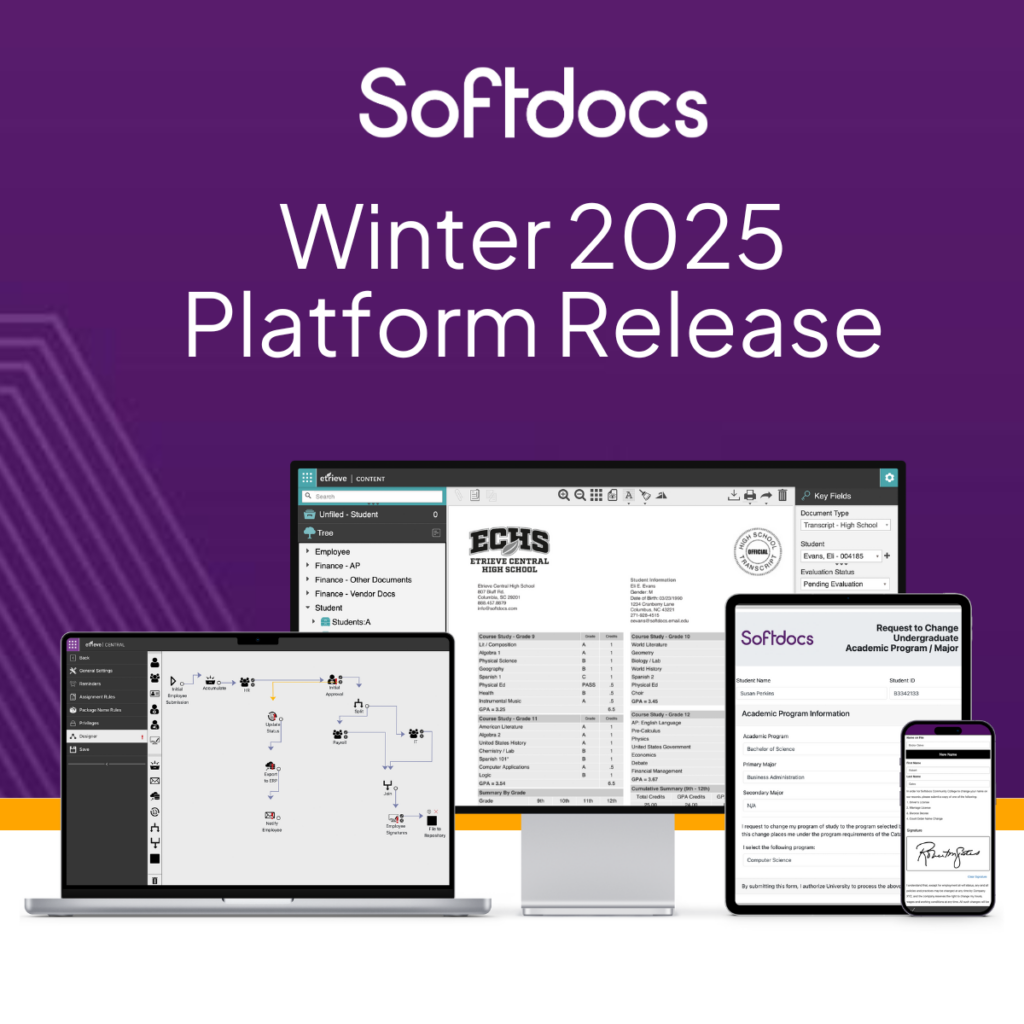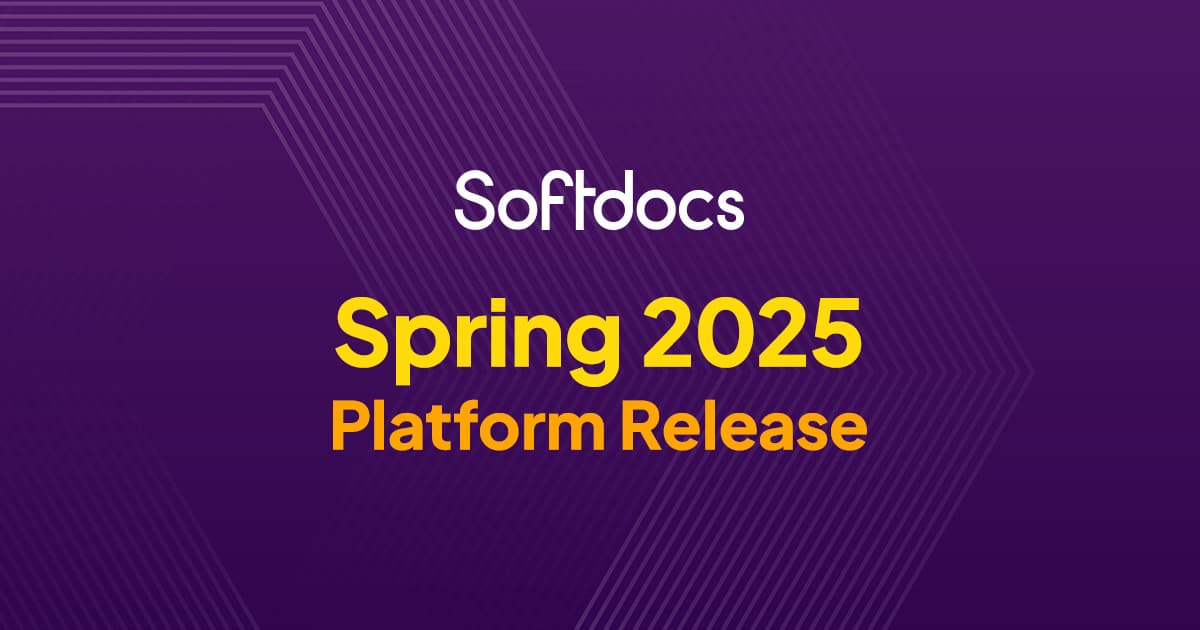It feels like your entire campus runs on forms. From complex processes in admissions, financial aid, and HR to unexpected processes like requests for mascot appearances, office supplies, or parking permits.
You know firsthand that these forms are more than just paperwork. They’re the most efficient and effective ways to collect, organize, and use information. And Softdocs eForms is the number one choice for campuses like yours. Its flexibility, built-in workflow, and integration give schools exactly what they need to capture precise information.
To show the power of Softdocs eForms, we’ve gathered some inspiring examples from customers. See how institutions are modernizing their approach and ensuring campus operations runs smoothly.
Rockingham Community College:
Supply Request Form
Who uses it: College employees
Number of forms involved in the process: 2
Whether it’s an instructor or the marketing department, employees need supplies like printer ink to dry-erase markers. That might seem like an unimportant process. But supply requests at Rockingham Community College (RCC) were causing far too much friction and frustration.
Previously, the college used a static Excel spreadsheet. Employees needed to download, edit, and then email the completed spreadsheet to the Facilities department. The process was clunky and prone to mistakes.
Here’s where it got tricky: supplies are constantly shifting. When inventory changed — like the price, quantity, or available color — the static spreadsheets failed to reflect those changes. As a result, employees would submit outdated, inaccurate orders. The Facilities department needed to go back and communicate those problems before finally fulfilling the supply order.
RCC moved its supply request process into Softdocs eForms to create a more dynamic, automated workflow. The new form integrates with RCC’s supply catalog to display available items with descriptions, sizes, colors, and price. After employees enter their desired quantities, the form automatically calculates totals for both the items and the entire order.
A Second Form Behind the Scenes
The facilities team also uses a second form they call a “utility form". Other college employees never see or use it. It serves as a dashboard where facilities can add or edit items. If the price of binders increases, staff updates the item via the utility form. The new information is then automatically reflected on the form that employees see.
Fulfilling supply orders is more straightforward now, too. Once a request is received, Softdocs generates a report. The report serves as the team’s “shopping list”.
These two forms took RCC’s supply request process from frustrating and fragmented to fast, frictionless, and foolproof.
Francis Tuttle Technology Center:
Account Creation and Application Form
Who uses it: Prospective students
Number of forms involved in the process: 2
Francis Tuttle Technology Center wanted to make its admission form as painless as possible. There was one snag. Because the form’s users were prospective students, they did not yet have an account for authentication.
Breaking this into two separate processes — one for account creation and one for application — would add too much complexity. So, FTTC set out to simplify.
Fortunately, Softdocs eForms enables people to submit a form using “anonymous access”. No login required. That meant Francis Tuttle could offer a straightforward process where the steps naturally linked together.
- Account creation form: The prospective student enters their demographic information.
- Automatic account creation: The system creates an account for them (using a temporary ID) so that they can log in.
- Application form: Using those login credentials, the student can access their application. Softdocs pulls in their demographic information from the first form so they don’t need to re-enter information.
Using this workflow, the college can make account creation and the application feel like one seamless step for students.
Several other form additions and automations helped Francis Tuttle further streamline this process further:
-
Connection to the Google Maps API
A student types their address into the form and then selects the correct one from the auto-populated dropdown. This improved user experience also enables FTTC to validats address data at the start.
-
Student ID creation
When a student’s application is accepted, the workflow automatically assigns a permanent student ID, replacing the temporary credentials.
-
Dashboards and data visualization
Softdocs connects to other systems so the student's data also moves to the ERP for zero duplicate data entry. This data powers new insights such as identifying all students who applied during the fall semester.
What could’ve been a disjointed, two-step process is now painless for students. And FTTC benefits from clearer, more accurate data.
Roger Williams University:
Student Refund Form
Who Uses It: Students, employees, or the bursar
Number of Forms Involved in the Process: 1
Students who have overpaid — whether it’s through financial aid or out of their own pockets — need refunds. The refund process can be surprisingly complex.
For Roger Williams University, the approval steps for a refund depend on the amount, the need for counselor input, and whether the student is an undergraduate, graduate, law, or Title IV student.
Also, constantly changing fee and financial aid information meant the bursar was often making decisions based on outdated data. Processing refunds required navigating multiple systems, manually verifying information, and coordinating across departments.
Roger Williams used Softdocs eForms to create a single, integrated refund request form. The form can be submitted by a student, employee, or the bursar on a student’s behalf. Softdocs' integration automatically pulls demographic and academic information into the form from Ellucian Colleague.
Once the form is submitted, the workflow sends the request to the bursar. They review the fees and award data. Depending on a variety of factors, it might proceed through one or more predetermined financial aid review steps. After that, the workflow sends the request to the associated bursar for final approval.
Adjusting for Changing Financial Information
To manage changing financial information, the form saves a "snapshot" of each student's fees and awards. This happens at different stages in the process. This ingenious solution lets reviewers see how the information looked when the request first entered the system. It also alerts the associate bursar if anything has changed by the time the request gets final approval.
An accompanying report also tracks the status of all refund requests — including both in-progress and completed requests. The report enables staff to filter and review data easily.
In total, the form incorporates 18 separate data integrations and connects multiple systems seamlessly into one process.
Students, employees, and the bursar all benefit from this new workflow. Requests move quickly, there’s less room for errors, and staff can focus on making informed decisions — not chasing down data.
Smarter Forms and Smoother Processes
Forms play a vital role in your campus operations. Fortunately, managing them no longer means juggling spreadsheets, untangling messy data across multiple systems, or repairing miscommunications between departments.
Softdocs eForms make it possible to streamline workflows, reduce errors, and keep information flowing smoothly. From simple requests to complex processes, the right tools and a thoughtful approach keep your institution in top form.
Softdocs
Tags


